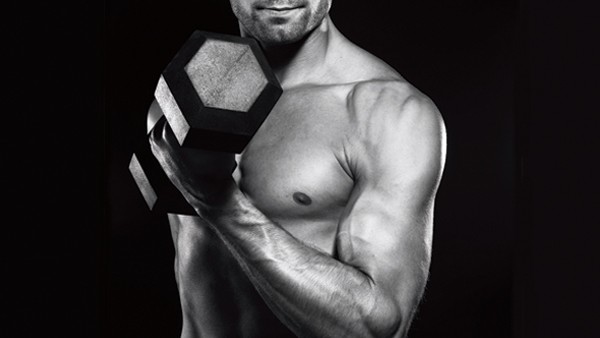
Sculpting your guns with arm curls to death? You'd be better off focusing on the larger muscles in your arms that will make a far greater sleeve-filling difference. Think triceps, not biceps to get ripped arms. Curls are fun and all, but your tris make up roughly two-thirds of the muscle in your arms, so by neglecting them you're short-changing your own gains.
The triceps, as the name suggests, are made up of three muscles compared with biceps two. You could join the hordes curling the night away in the gym, or you could put your time to better use with exercises that'll strengthen and expand all the muscles in your arms.
RECOMMENDED: Five Tips for Bigger Arms
Beautifully, you can grow your chest – the other mirror-friendly muscle group – in perfect harmony with your triceps. Their job is to straighten your elbow, so they come into play every time you push something away from your body, such as when you bust through a door, or, bench press a monumental weight off your chest. On the other hand, or arm, the biceps go well with exercising your back because they both involve pulling movements.
1 Lift big
Begin each arms workout with multi-joint exercises, called compound lifts. These target several muscle groups at once, causing your body to release lots of anabolic muscle-building hormones such as testosterone and human growth. These natural chemicals will prime your muscles to grow for the rest of the session. So before you run for the cable pulldown contraption to grow your triceps, make way for the bench press or dip station. Before hogging the preacher curl bar for your biceps, spend time under the chin-up bar or with under-arm bent-over rows instead. Target five sets of five reps with a reasonably heavy weight, resting 60-90 seconds between each, then you can turn the spotlight on the bis and tris directly.
2 Isolate to accumulate
Once your body is prepped to grow, you can focus on the arms muscles in isolation with dumbbell curls, triceps dips, seated hammer curls and overhead extensions. At this point you want to stop the bigger, stronger muscles in your back or chest taking over. Avoid using momentum to swing the weights. Lean back against a wall or back on a bench set to a 45˚ incline when doing curls will help. Using resistance bands or cable machines also helps keep tension on the specific muscles throughout the lifting and lowering part of each rep that will work the target muscle harder. At this point, high reps between 10-15 are challenging, but most effective.
3 Welcome failure
Easy is rarely effective in the muscle building stakes. If you want to stimulate arm muscle growth it’s important that you increase the intensity of your exercise. Rather than just lifting what you already know you can manage with ease, you need to aim to increase the weight or the number of reps that you’re performing on each workout. As long as your form is still good, you should be struggling to lift the final two reps when doing compound (such as the bench press) or isolation (arm curls) exercises. Following the isolation moves you can increase the workload on the muscle by reducing the weight you're lifting slightly and immediately repeating the number of reps you first did with the load. Expect this to burn a little. It will ease as soon as you put the weights back down.
Get the Coach Newsletter
Sign up for workout ideas, training advice, reviews of the latest gear and more.
4 Reach your full range
For maximum biceps and triceps development, and arms that look natural and strong, you need to lift through a full range of motion with each rep. To keep you honest, squeeze the muscle you're working at the top and bottom of the movement. So with arm curls, raise the weight towards your shoulder and tense your biceps hard for one second, then lower the weight until your arm is fully straight and tense your triceps hard for a second. It might feel slow. You might have to reduce the weight at first, but it'll grow every muscle fibre in your arm instead of letting some get lazy on the job.
5 Stretch your goals
Yes, you might be pushed for time at the gym but always try to make time to stretch. Doing this after you train your arms will help with recovery and there is ample evidence that stretching these muscles will also extend the fascia. Think of fascia like a white sock over your muscle that restricts their growth. The more that you open it up, the more space that you’ll have to build more muscle. This type of stretch is quite intense, not your usual light pre-workout moves, more weighted and lengthy stretches that really open your muscles up.
6 Hasten recovery
If you follow the above to the letter, and aren't used to this type of comprehensive arm training, it's likely your arms will feel especially sore the next day or two. Relax, this is normal, but it doesn't mean you just have to take it on the chin/elbow. You can help your muscles recover and the soreness subside by gently reworking the muscles through the same movements that put them in this condition. Using substantially lighter weights, a resistance band or even without weight at all, do a few reps to work your biceps and triceps. It'll get blood recirculating in the muscle fibres, helping remove toxins caused by the previous day's excesses and replenish oxygen and other nutrients to speed up their repair. Let your arms recover fully before returning back to the gym and picking up where you left off.

Sam Rider is an experienced freelance journalist, specialising in health, fitness and wellness. For over a decade he's reported on Olympic Games, CrossFit Games and World Cups, and quizzed luminaries of elite sport, nutrition and strength and conditioning. Sam is also a REPS level 3 qualified personal trainer, online coach and founder of Your Daily Fix. Sam is also Coach’s designated reviewer of massage guns and fitness mirrors.
